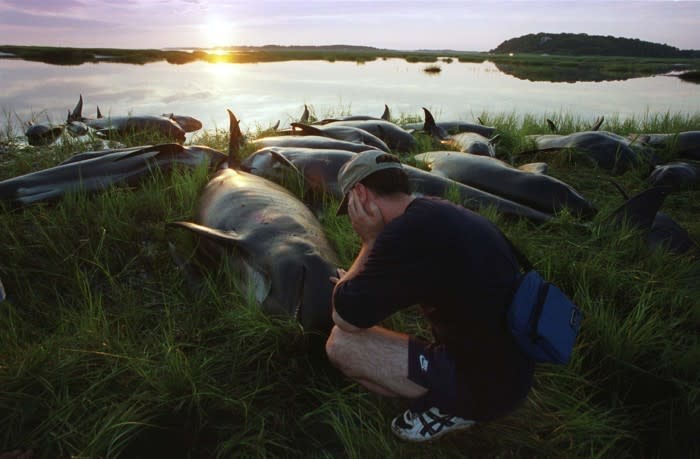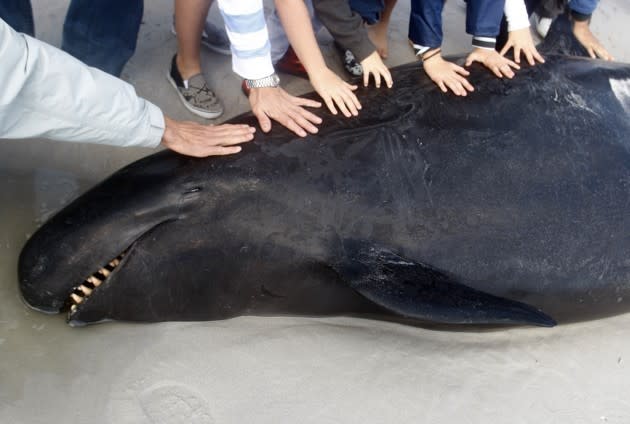Once Again, a Massive Group of Whales Strands Itself
The short-finned pilot whale is a large species of dolphin with a dark-grey body and a bulbous head. It’s an intensely social animal that spends its life in the company of others. And that, sadly, is also how it sometimes dies.
On Thursday night, around 150 short-finned pilot whales stranded themselves at Hamelin Bay, a site on Australia’s western coast around 200 miles south of Perth. If they land on solid surfaces, their chest walls, no longer supported by the weight of the water, start to compress their internal organs. When a fisherman spotted them in the early hours of Friday morning, most were already dead. By 7 p.m. local time, trained staff and volunteers had hauled six survivors back into the sea, but their fate is still uncertain. Rescued whales often re-strand themselves, and nightfall will make their movements harder to track.
Western Australia is no stranger to mass whale strandings. Nine years ago, to the day, 80 long-finned pilot whales—a closely related species—stranded themselves in the very same spot. Three years ago, again almost to the day, around 20 long-finned pilot whales washed up at Bunbury, about 70 miles to the north. And those incidents pale in comparison to the largest mass stranding ever documented in the region. In the summer of 1996, 320 long-finned pilot whales beached themselves at Dunsborough, less than 50 miles to the north.

This isn’t a uniquely Australian problem. New Zealand’s Farewell Spit is a notorious whale trap where pilot whales regularly strand; up to 650 long-finned pilot whales beached there last February, of which 400 or so were saved. Cape Cod is another hot spot, and sees an average of 226 stranded whales and dolphins every year. Pilot whales seem especially susceptible, but even larger species will beach themselves. Over 300 sei whales died at a Chilean fjord in 2015, while 29 sperm whales washed up on the coasts of the southern North Sea in 2016.
Recommended: Trump Can't Get What He Wants and Doesn't Know Why
The largest mass stranding in recorded history occurred a century ago, when 1,000 whales came ashore at the Chatham Islands. And even older strandings are evident from Chile’s Cerro Ballena, a roadcut from which scientists have uncovered the skeletons of at least 40 stranded whales, between 6 and 9 million years old. Given this long history, it’s unclear if these events have become any more frequent of late, or if they’re simply easier to spot in an interconnected world.
Still, there is something deeply unsettling about mass strandings. Cetaceans—the group that includes whales and dolphins—are highly intelligent and beautifully adapted to life in the water. Why would they leave the aquatic world to risk death? And why do so many of them do so at the same time?
No one really knows. There’s a multitude of hypotheses and few firm answers.

Location matters. Stranding hot spots like Cape Cod and Farewell Spit often include hook-shaped pieces of land jutting out into the water. The gently sloping sandy beaches at these sites may not reflect the whales’ sonar back at them, prompting them to think that they’re actually in deeper water. These regions are also complicated estuarine environments where rapidly receding tides can easily strand inexperienced deepwater species. Perhaps this is why shallow-water cetaceans, which have most experience with such conditions, rarely strand. Perhaps this also explains why pilot whales will often re-strand themselves once they’re rescued.
Recommended: Marriage Proposals Are Stupid
Whales might enter these traps because they’re pursuing prey into unfamiliar waters (as was possibly the case for the sperm whales that died in the North Sea in January 2016). Or they might be fleeing from predators like orcas, or be sent astray by extreme weather. They might be weakened by injuries, viral infections, or mere old age, and seek shallower waters where they can more easily breathe.
They might even be influenced by astronomical events. Many cetaceans use the Earth’s magnetic field to navigate, and their internal compasses could be vulnerable to magnetic anomalies, of the kind caused by solar storms. The sun occasionally lashes out with streams of charged particles and radiation; these cosmic tantrums produce the magnificent northern lights, but perhaps they’re also responsible for disorienting cetaceans, sending them into dangerous waters. It seems like a far-fetched possibility, but it’s one that NASA is seriously investigating.
It’s possible that some stranding cetaceans are the victims of natural poisonings. The sei whales that died in Chile are thought to be victims of toxins released by deadly algae, while similar harmful algal blooms may also be responsible for the fossil whale graveyard at Cerro Ballena.

Cetaceans can be disoriented by the underwater din of human activity, from naval sonar to the seismic airguns used in oil and gas exploration. Several stranding events have been tied to military exercises near the United Kingdom, Denmark, Greece, the Canary Islands, Hawaii, and most famously, the Bahamas in 2000. As documented in War of the Whales, that last event led to a string of scientific studies, legal injunctions, court cases, and a formal admission of culpability from the U.S. Navy. Naval sonar is so loud that it can cause internal hemorrhaging. It could also cause gas bubbles to form in cetaceans’ bodies, essentially giving them the bends—the same condition that afflicts human divers who surface too quickly. Even low levels of sonar could harm cetaceans by distressing them, forcing them to flee into unfamiliar territory.
Recommended: 'Wild Wild Country': The Jaw-Dropping Story of the Cult Next Door
Finally, many cetaceans live in large groups. They play together, travel together, and hunt together. And perhaps, as a result, they die together. If one faltering individual, whether through confusion, sickness, or naïveté, heads toward a shoreline, it’s possible that the entire group will follow it to their doom, in the way that lemmings have been mythologized to do (but actually don’t).
Many of these hypotheses are difficult to test, let alone prove, and it’s likely that many of them are correct. It would be a mistake to let the heartbreaking nature of these events cloud the fact that they vary considerably in the species that are affected, their location, and the circumstances around their deaths. It seems unlikely that there will ever be a Grand Unified Theory of Mass Strandings. Instead, per Tolstoy, perhaps every stranded group of whales is stranded in its own way.
Read more from The Atlantic:
This article was originally published on The Atlantic.

